The article “The Sarmatian Connection: Stories of the Arthurian Cycle and Legends and Miracles of Ladislas, King and Saint” reproduced below is by János Makkay of the
The New Hungarian Quarterly, Volume 37, no. 144, Winter 1996, pp. 113-125.
Note that the article below has printed the major portions of the article and not its entirity. Interested readers are referred to the New Hungarian Quarterly for more information.
Kindly note that none of the images and accompanying descriptions have appeared in the original article and/or any other previous postings of this article.
====================================================================
Under the Emperor Marcus Aurelius (161-180) the Roman Army campaigned for eight years in Pannonia Barbarica (i.e., in the central and northern parts of the Carpathian Basin, north and east of the Roman limes along the Danube) against the Quadi, a German tribe, and Sarmatians and Alans, Iranian speaking barbarians who came from east of the Carpathians, from the south Russian steppe and from the Lower Danube Plains near the Black Sea. After hard but victorious battles, 5,500 Sarmatian/Alanian heavy cavalry (called cataphractarii, i.e. clothed fully in scale armour) consisting of prisoners taken in war were posted to Britain in 175. Marcus Aurelius sent these warriors to Britannia not only to keep them out of trouble in Pannonia Barbarica but also to deploy them beyond Hadrian’s Wall.2 These Sarmatians are known to have been stationed in permanent camps outside the Roman forts at Ribchester in Lancashire, Chester, and elsewhere. The Sarmatian enclaves – especially the one at Ribchester, a Lancashire site known in ancient times as Bremetennacum veteranorum – survived until the end of the Roman era in the late 4th century A.D.

Fig. 1. Roman tombstone from Chester (housed at Grosvenor Museum, item #: 8394907246), UK depicting Sarmatian horseman attired like other kindred Iranian peoples such as the Parthians and Sassanians (Source: Carole Raddato, uploaded by Marcus Cyron in Public Domain).
The tombstone fragments of a Sarmatian/Alanian standard bearer were found at Chester (Deva) in 1890. This is unique evidence of the presence of heavily armoured Sarmatian cavalry from the earliest third century A.D. The two fragments of the tombstone (now in the Grosvenor Museum in Chester) show a horseman wearing a cloak and turning to the right. He holds aloft, with both hands, a dragon standard of the Sarmatian/Alanian type, and his conical helmet, with a vertical metal frame, is of the same pattern. A sword hangs at his right. Both man and horse are shown clad in tightly fitting scale armour. This attire for man and mount was characteristic of Sarmatian/Alanian heavy cavalry.
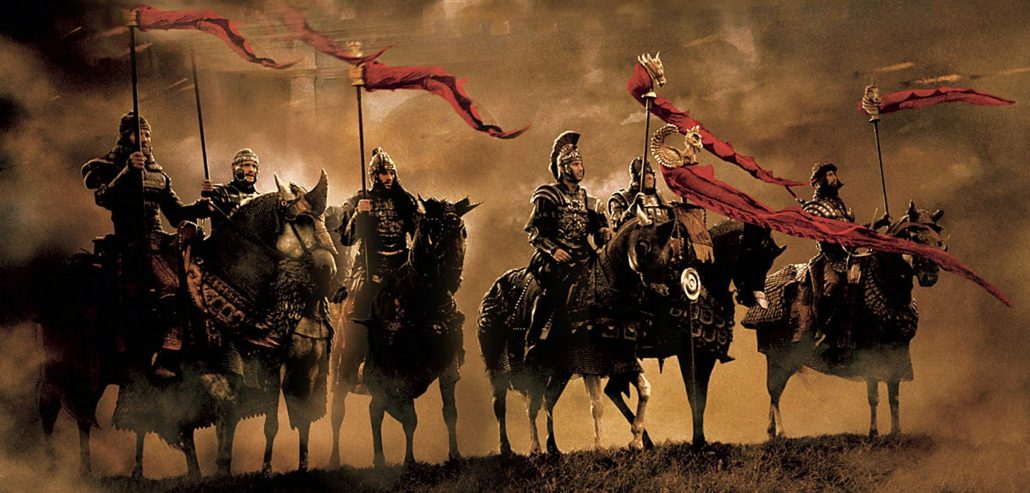
Fig. 2. Russian reconstruction of King Arthur and his Sarmatian cavalry (Source: Our Russia); note Iranian dragon standards of the cavalrymen also seen in the armies of the parthians and Sassanians.
he original dragon standard shown on the tombstone had a metal head and a cloth body designed like a windsock so that the animal appeared to come alive in the wind. It has been suggested that these standards may have indicated the position of the given Iranian troops and their command posts during the battle and also the wind direction for the Sarmatian/Alanian archers. The best description of this characteristic Iranian tactic and symbolism is in the Tactica of Arrian of Bithynia (2nd century A.D.) who defeated the Alanian invasion of 134. He must have had exact knowledge of how the Iranian peoples conducted themselves in war.3 We know that the military symbol of the kings of the Parthians (as for instance of Mithridates I. in 139 B.C.) was a dragon standard made of textile or leather.4 There is no indication, however of the use of similar standards in Achaemenid times.
The closed society of Sarmatian cataphractarii in Britain was able to maintain its ethnic features during the Late Roman period and afterwards. One reason is that their troops, called cuneus Sarmatorum, equitum Sarmatorum Bremetennacensium Gordianorum were not part of any military organization in active service. Consequently, after the withdrawal of the Roman army, they continued to live on their accustomed sites (Chester, Ribchester, etc.). They were still called Sarmatians after 250 years. A semihistoric Arthur lived about A.D. 500. He was very probably a descendant of those Alan horsemen, a battle leader of the Romanized Celts and Britons against the Anglo-Saxons, who invaded Britain after the Roman army had withdrawn. Arthur and his military leaders could therefore manage to train the natives as armoured horseman after Iranian patterns against the attacks of Angles and Saxons fighting on feet until their victory at Badon Hill.
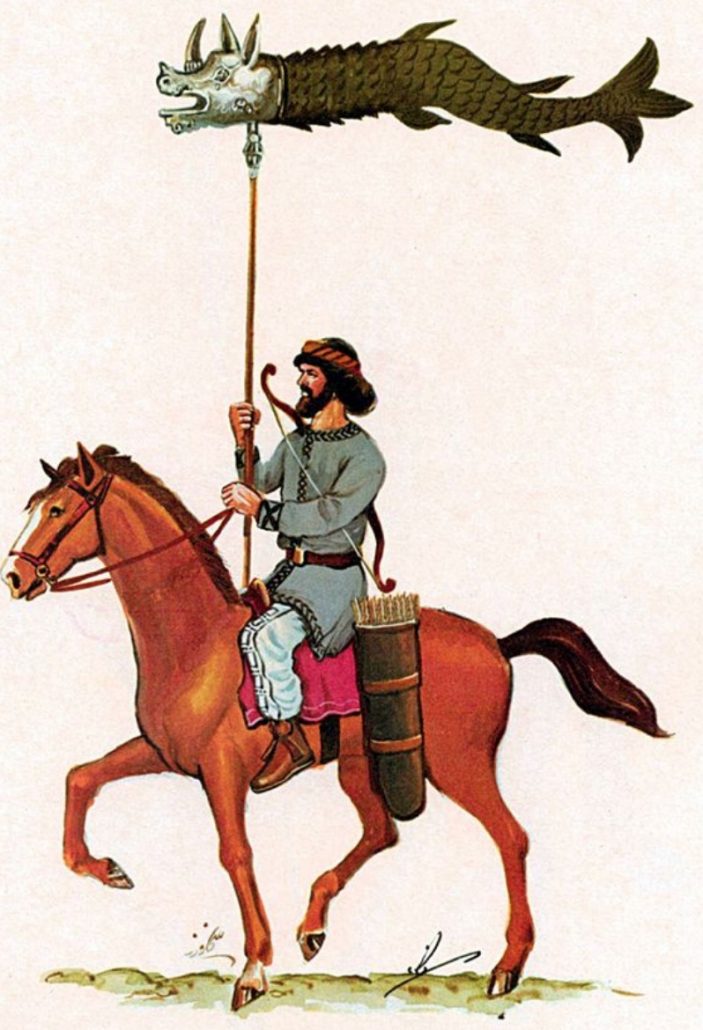
Fig. 3. Parthian standard bearer with Draco standard (Source: Farrokh, page 130, Shadows in the Desert: Ancient Persia at War-Персы: Армия великих царей-سایههای صحرا– this drawing originally appeared by Zoka in the 2,500 Year Celebrations of the Persian Empire in 1971).
Geoffrey of Monmouth’s Historia Regum Britanniae contains detailed accounts of the traditional Roman military tactics used by the army of Arthur in his legendary wars against the Romans.5 He also mentions the dragon standard of the Arthurian army which was set up at a suitable and easily defensible place to show exhausted and wounded warriors where they could find drinking water and have their wounds dressed.6 His own golden helmet was decorated with a dragon, probably the same dragon which appeared to him in a dream while crossing the Channel. Sir Thomas Malory recounted the story as follows:
And as the kyng laye in his caban in the shyp, he fyll in a slomerynge and dremed a merueyllous dreme. Hym semed that a dredeful dragon dyd drowne moche of his peple, and he cam fleynge oute of the West, and his hede was enameled with asure, and his sholders shone as gold, his bely lyke maylles of a merueyllous hewe, his taylle ful of tatters, his feet ful of fyne sable, and his clawes lyke fine gold, and an hydous flamme of fyre flewe oute of his mouthe, lyke as the londe and water had flammed all of fyre.7
What Geoffrey of Monmouth and Malory describe is the peculiar features and use of the military dragon standard by the Iranian peoples and, later, by the Roman army. According to Ammianus Marcellinus, on the triumphal procession of Constantius II in Rome in 357 the Emperor sat alone upon a golden chariot “… and was surrounded by dragons, woven out of purple thread and bound to the golden and jewelled tops of spears, with wide mouths open to the breeze and hence hissing as if roused by anger, and leaving their tails winding in the wind.”8
The dragon standard on the Chester tombstone (a metal head and a cloth body) closely corresponds to two unique archaeological finds, both made of metal and representing the heads of dragon standards. One of them is of bronze and was found in the canabae area of the Roman castellum at Niederbieber, Nordrhein-Westfalen. It dates from the first part of the 3rd century A.D. It has a length of 30 cm, is gilded on its upper part while the lower part is silvered (see the description in Malory). It shows an open-mouthed dragon head with sharp teeth and has a widening rim at its back end with perforations for fastening textile stripes, while a wide vertical perforation across the body served to fit the head to the top of a spear, lance or simple pole.
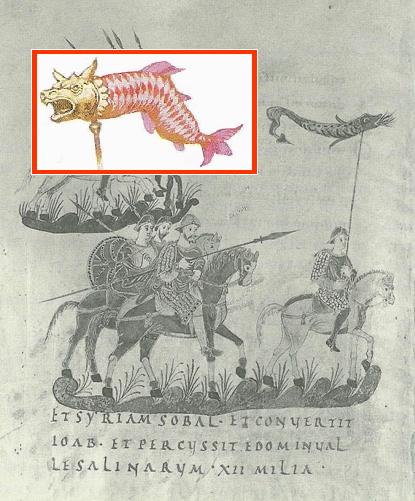
A depiction of Geoffrey of Monmouth’s Historia Regum Britanniae and Sir Thomas Mallory’s Le Morte d”Arthur. Note the windsock carried by the horseman (Farrokh, page 171, Shadows in the Desert: Ancient Persia at War-Персы: Армия великих царей-سایههای صحرا) – this item was bought from the wider Iranian realm (Persia, Sarmatians, etc.) into Europe by the Iranian-speaking Alans. The inset depicts a reconstruction of a 3rd century AD Partho-Sassanian banner by Peter Wilcox (1986).
The other piece is in the Hermitage in St Petersburg. It is made of silver and comes from the Government of Perm in Russia. This Sassanian piece of the 7th century A.D. shows a dragon-like head of hybrid (dog- or wolf-shaped) character with an open mouth and chased embossé decoration. It also has a vertical perforation for a pole.9
These two pieces in fact have a third parallel. It is a gold dragon standard head found in the Sargetia valley, Transylvania, around 1543, which once belonged to the royal treasures of the Dacian king Decebalus and was hidden in the early autumn of 106 A.D., at the end of Trajan’s second Dacian war.10 Descriptions of the circumstances under which the discovery was made by Trajan in A.D. 106 and then in 1543 of these large treasure troves reveal many details of a belief in a dragon-guardian – as the Beowulf calls it: hordweard.
Recently, in a series of publications, Helmut Nickel and C. Scott Littleton argued that the roots of the legends of King Arthur and the Knights of the Round Table, as well as those concerned with the Holy Grail, are not to be found in the indigenous Celtic traditions of the British Isles, as most Arthurian scholars hold, but rather in a “Scythian tradition”12 that seems to have originated from the religious beliefs of Iranian Sarmatians/Alans of the Hungarian Plain of the 2nd century A.D.
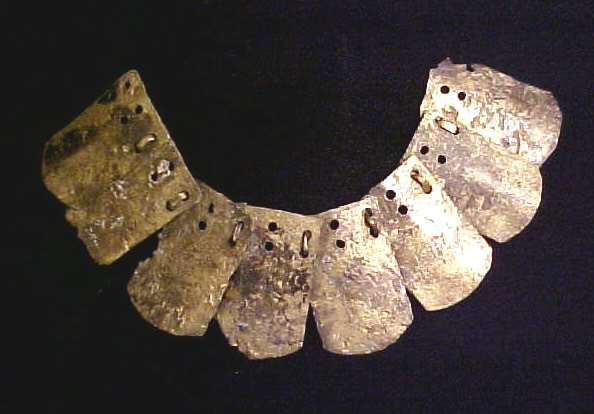
Fig. 5. Sarmatian armour discovered near Hadrian’s Wall in England (Source: Periklisdeligiannis); this most likely belonged to an Iranian-speaking Alan or related Ia-zyges cavalrymen serving as mercenaries in the Roman army in Britain.
These beliefs centre around the divine sword, the sacred cup of heavenly splendour, the dragon standard as military symbol, and early literary traditions connected with them. The resemblances are not limited to mythology. In some cases artefacts (as for example scale armour and standards) or representations, strongly related to mythological-religious matters were also similar. Now, our whole story starts with such one material connection, with the golden serpentine dragon symbol of the Dacians.
The most intriguing parallel of the triple combination of dragon standards, heavy Iranian cavalry and scale armour appears in recently excavated finds in Uzbekistan. In the cemetery of Orlat two bone plates were discovered in kurgan grave 2, measuring 13,5 x 10,5 cms.13 They are decorated with finely engraved motifs, and one of them represents eight heavily armed men in individual combat. Five are horsemen while three are fighting on foot. Their weapons are swords, long spears, bows and in one case, a battle axe. All of them wear scale armour. One of the horsemen with a very long spear holds a dragon standard which closely resembles the lower (textile) part of the above discussed standards in every detail (see Fig. 6). The plate dates from between the 2nd century B.C. and the end of the 1st century A.D., and the warriors can be identified as Central Asian Alans.
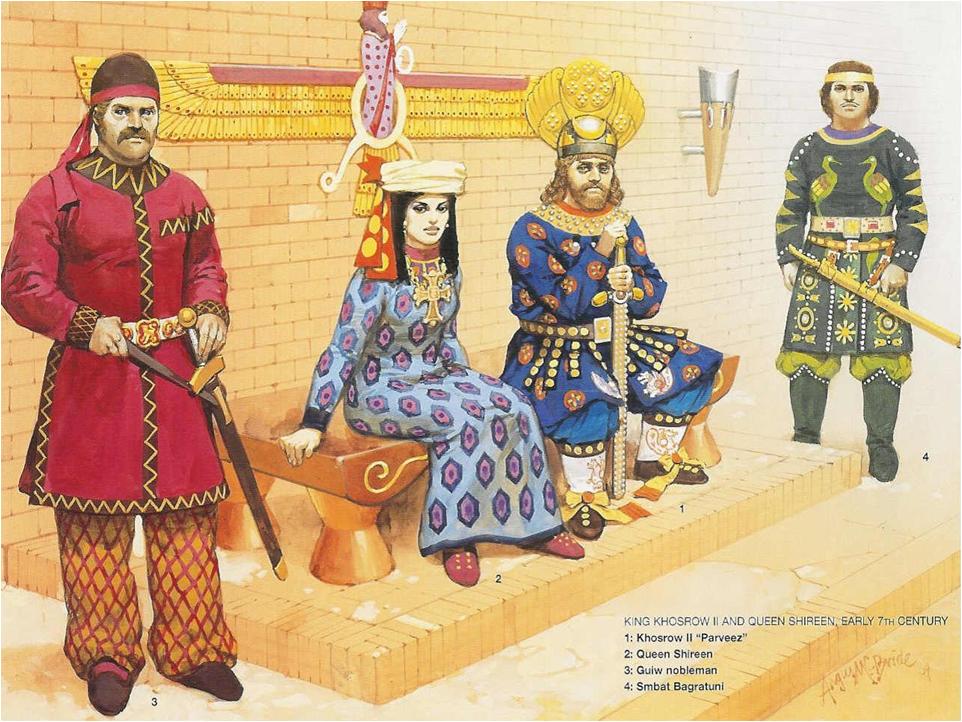
Fig. 6. Sassanian court of Khosrow II and his queen Shirin (Source: Farrokh, Plate F, p.62, -اسواران ساسانی- Elite Sassanian cavalry, 2005); note the monarch who sits with his ceremonial broadsword. The Sarmatians shared the culture and martial traditions of their Iranian kin, the Parthians and the Sassanians.
A gold plaque of Iranian character from the Siberian collection of Peter the Great dated around 300 B.C. (See Fig. 8.)27 shows a woman seated under a tree, holding a
sleeping man’s head in her lap, and a pair of horses, held by a groom, standing by. The weapons of the warrior, bow and quiver, hang in the branches of a tree. It is not difficult to recognize the scene of Walther’s sleep before the fight in the representation on the plaque.
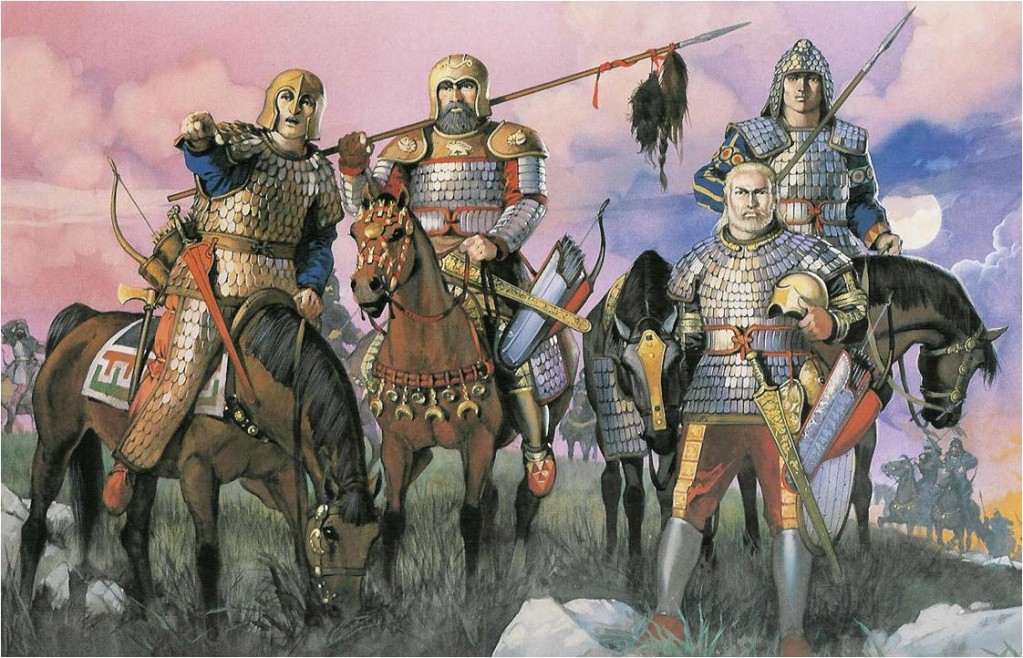
Fig. 7. Scythians on the steppes of the ancient Ukraine. Scholars are virtually unanimous that the Scythians were an Iranian people related to the Medes and Persians of ancient Iran or Persia (Painting by Angus McBride).
The same scene of repose, however, is well-known from early medieval Hungarian wall paintings centering around Ladislas, King and Saint of the House of Árpád (1077-1095). As Gyula László has shown in a masterful book, the story goes back to eastern, Iranian (or Iranized Turkic) elements, before the Hungarians were christianized after 1000 A.D. onward.28 His research, and that of others, also showed that this motif from the 13=14th century is central in the still extant Hungarian folk ballads Molnár Anna and Kerekes Izsák from Transylvania. In the Saint Ladislas legend a Hungarian princess is abducted by a warrior of the Turkish Kumans. As represented on the wall paintings of the Bántornya medieval church, while they are resting under a shady tree, the warrior asks the princess to take his head in her lap. When he falls asleep, the pursuing knightly saint catches up with them and after a heavy fight will the abductor he liberates the princess.
Another and more common variant of the story is when the king kills the Cumanian raider with the help of the girl after a heavy duel and becomes himself wounded .29
We have an interesting complex of additional elements connecting these and further details of the Arthurian story, the Nibelungen cycle, the Saint Ladislas Legend and Hungarian folk ballads: the nine branches of the tree, the escape of the lady into a cleft (or in a cavity of a tree), murder (usually beheading) of the girl with a sword, hanging of the head in the tree, hanging of the weapons and helmet of the warrior in the branches of a tree, the gentle fondling of the warrior’s hair by the girl, and finally, when Hildegund dresses the wounds of Walther and Hagen, and offers them a drink in a golden bowl.
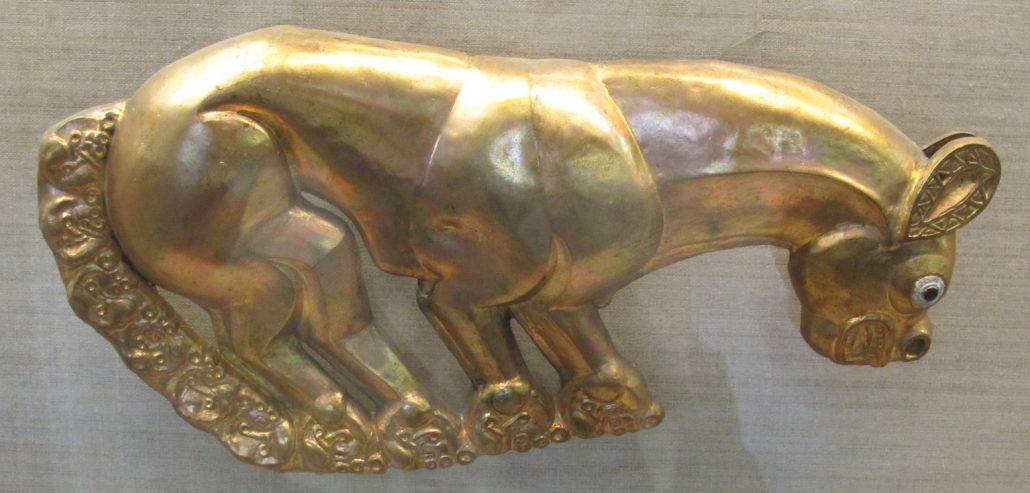
Fig. 8. Gold plaque housed in the Hermitage Museum in St. Petersburg depicting a panther, most likely used to decorate breast-plate or shield, dated to the late 7th-century BCE (Source: Sailko in Public Domain).
The original story of the sleeping maiden-abductor (or occasionally of the escorting knight) under a tree seems to have originated in Central Asia and has ancient Middle Iranian sources. The scene was probably a central part of a myth from a by now forgotten Central Asian heroic epic. Nobody has tried to show so far that this Hungarian legend may be a result of Iranian influence on early Hungarian folklore and related somehow to a local “Sarmatian tradition” surviving in the Carpathian Basin. The surviving Sarmatian/Alan population of the Great Hungarian Plain (from the fifth century A.D. to the coming of the Magyars) would be the medium. These Iranian (Sarmatian/Alan) tribes of the great Hungarian Plain were to be linguistically absorbed by the Magyars. The above motifs in Hungarian legends and folklore have their parallels in the Arthurian legends and the Nibelungen cycle and – in this view – go back to the same source, namely the influence of Iranian Alans. First to those 5,500 warriors who were sent to Britain by Marcus Aurelius, and later, in the second half of the fourth century A.D. when Alan tribes fled from the invading Huns and established themselves in Italy, in Gallia Transalpina and in the Rhine valley. A great many Sarmatian and Alan warriors also served in the Roman army in the fourth century A.D. The Sarmatian/Alan connection as traced in Hungarian medieval legends appears further to confirm what was suggested about the Eastern, Iranian, connections and origin of the Arthurian legends and its related details including the motiv of the Holy Grail.
Footnotes
2 * I. A. Richmond: “The Sarmatae, Bremetennacum Veteranorum, and the Regio Bremetennacensis”. Journal of Roman Studies 35, 1945, pp. 16=29. I express my thanks for help and advice to Tom Strickland, Chester.
3 * Arriani Nicomediensis: Tacticá, 35, 1=5. For other ancient sources see Vegetius: Epitoma rei militaris, ii, 13.; Sidonius Apollinaris: Panegyricus Maioriani, Carmina v, 402.; Nemesianus: Cynegetica, 82. – Trebellius Pollio in Historia Augusta, Gallienus, 8.; Codex Iustinianus, 1, 27.; Lucianus Sophista: Quomodo historia conscribenda sit, 29. – [Flavius Vopiscus Syracusius]: Historia Augusta, Divus Aurelianus, xxxi.; Ammianus Marcellinus, xvi, 12, 38=39 and also xv. 5, 16.
4 * János Harmatta in Antik Tanulmányok (Studies in Antiquity) 28, 1981, pp. 111 and 129=131.
5 * Book IX, 1, 3, 4, 11, X, 3, 6, 9, 11, esp. Book X, l, and also XI, 2.
6 * Book X, 6. The dead body of Sir Bedivere was also brought to the same place: Book X, 9.
7 * Caxton’s Malory. A new Edition of Sir Thomas Malory’s Le Morte Darthur, ed. by James W. Spisak, (referred as Morte Darthur). Berkeley and Los Angeles, 1983, p. 124, i2recto, 4, Book v. 4. – Historia Regum Britanniae, Book X, 2.
8 * Ammianus Marcellinus xvi, 10, 6=7. Loeb Classical Library.
9 * K.V. Trever: Un étendard Sassanide. Musée de l’Ermitage, Travaux du Département Oriental, tome III, Léningrad, 1940, pp. 167=78, Pls. I-II.
10 * For a detailed account see János Makkay: “Decebál kincsei – The Treasures of Decebalus”. Századok, 129, 1995, pp. 967=1032, and by the same author: “The Treasures of Decebalus.” Oxford Journal of Archaeology 14:3, 1995, pp. 333=43, with further literature.
[…]12 * C.Scott Littleton – A.C. Thomas: “The Sarmatian Connection: New Light on the Origin of the Arthurian and Holy Grail Legends.” Journal of American Folklore 91, 1978, pp. 512=27.; C.Scott Littleton: “The Holy Grail, the Cauldron of Annwn, and the Nartyamonga. A Further Note on the Sarmatian Connection”. Journal of American Folklore 92: 365, 1979, pp. 326=33. C. Scott Littleton: The New Comparative Mythology. Berkeley, Los Angeles, 1982.; C. Scott Littleton: “From Swords in the Earth to the Sword in the Stone: A Possible Reflection of an Alano-Sarmatian Rite of Passage in the Arthurian Tradition” In Homage to G. Dumézil. Washington, 1983, pp. 53=67.; C. Scott Littleton – Linda A. Malcor: From Scythia to Camelot. A Radical Reassesment of the Legends of King Arthur, the Knights of the Round Table and the Holy Grail. New York-London, 1994; Helmut Nickel: “Wer waren König Artus’ Ritter? Über die geschichtliche Grundlage der Artussagen.” Waffen- und Kostümkunde 17: 1, 1975, pp. 1=28.; Also by the same author: “About the Sword of the Huns and the Urepos of the Steppes.” Metropolitan Museum Journal 7, 1963, pp. 131-42.
13 * G.A. Pugatsenkova: Iz khudozestvennoi sokrovishnitsy Srednevo Vostoka. (Ancient art treasures of Central Asia).
[…]27 * Nickel, op. cit. 1975. pp. 4=5, and Fig. 3.
28 * Gyula László: A Szent László-legenda középkori falképei (The Legend of Saint Ladislas and its Representations on Mediaeval Wall Paintings). Budapest, 1993, pp. 24=56 with many figures, pictures and earlier literature.
29 * The well-known story told by our medieval chronicles is connected with the victory of the king – then a royal prince – against the Cumans at Kerlés, Transylvania, in 1068.
[…]


